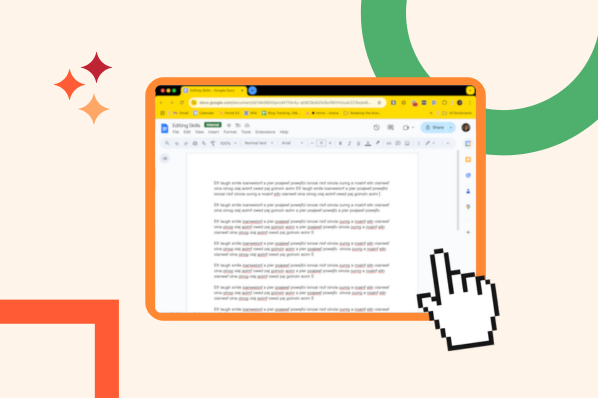12 Editorial Skills You Need to Become a More Efficient Editor
- December 2, 2024
- Knowledge Base
- 0 Comments

I consider myself to be a good editor, but I only got to where I am today by practicing my editorial skills.
Being a good editor is a muscle you have to practice.
In this piece, I’ll go over how to improve your editing skills with 12 strategies I used (and still use) to edit more efficiently while maintaining the integrity of the original author’s words.
What are editorial skills?
Editorial skills refer to the abilities you must have to effectively review content, make corrections, provide feedback, and improve it. As an editor, you must exhibit strong skills in the following areas: writing, storytelling, proofreading, research, grammar, and vocabulary. Beyond that, you must also be detail-oriented, creative, a good communicator.
I self-edit everything I write for the HubSpot Blog. I also run Breaking the Blueprint, a blog column that primarily publishes content by external contributors whose writing I have to edit.
The editing skills I’ve developed help me ensure that my writing, and that of external writers, is good and helpful for readers like you. Let’s go over some of my tried and true methods.
12 Ways to Save Time While Editing a Piece of Writing
1. Find a quiet space to do your editing.
Don’t try to get your editing done in a meeting, or when you’re around chatty coworkers.
Research shows that multitasking like that can make us far less effective at our work and increase mistakes and stress. And when you’re editing, you’re trying to catch those mistakes so you want to be extra diligent.
Instead, I suggest finding a place where you can plug in and concentrate on what’s in front of you. If you’re working through a piece of writing that’ll require more than a few hours of careful editing, block out chunks of uninterrupted time with small breaks in between (the Pomodoro method).
Since it can take 23 minutes to get back on track after receiving a notification, you might consider turning off those pesky email and social media notifications or putting your phone on airplane mode to really hone your focus.
2. Be sure the topic aligns with your content strategy.
You might be tempted to dig into the meat of the piece and begin meticulously editing it straight away.
As editors, it’s important for us to put the content into context before diving into the details.
First, take a quick skim of the working title and the main ideas covered in the piece. Think to yourself:
- Does this topic align with our content strategy?
- Will our readers and buyer personas care about it?
- Does each section flow naturally into the next?
If you’re concerned the piece isn’t about a topic your readers will be interested in, think about how to tweak the angle.
You’ll also want to reflect on how the piece fits in with what you’ve written in the past — especially if the piece is a blog post.
Search engines like Google might see the second post as duplicate content and penalize you in search.
Even if Google doesn’t consider it duplicate content, competing for keyword ranking against another post from your own blog will hurt your SEO strategy.
The questions I recommend asking here are:
- Have we covered this topic comprehensively in the past?
- Does this offer a fresh angle and perspective?
If both answers are yes, you might consider updating and republishing the original draft.
3. Read for content and ideas first, grammar second.
I recommend reading through the entire piece before making detailed edits. This will help you reflect on it holistically and pinpoint areas for improvement.
This may seem like I’m adding time here, but trust me, this will save you a lot of time and pain in the long run. If you’ve ever started editing a piece line-by-line only to realize it needs to be completely restructured, you know what I mean.
The key takeaway here is to recognize when the piece needs more work from the author.
“Sometimes, an author sends a piece in before it’s ready to be edited,” said Corey Wainwright, HubSpot’s Website CRO strategist & copywriter at HubSpot.
“Learning to recognize those instances can save you a ton of time because otherwise you start just rewriting the piece, which isn’t helpful to either of you.”
Ginny Mineo, former Marketing Blog manager at HubSpot, agrees: “Your job, as an editor, is to preserve the voice of your writer while making sure they are meeting your quality bar.”
If you notice the piece doesn’t flow well, the introduction needs to be tightened up, or there aren’t enough points in the article to meet your quality standards, I recommend sending that feedback to the author.
It’ll be more productive than changing everything around yourself.
If the piece needs an overwhelming amount of editing help, then the author’s writing may not be a fit for your publication – and you’ll save a lot of time by telling the contributor outright.
4. Check for places where the author can fill in the blanks.
Aside from providing larger, more broad feedback, you should also read through the piece to identify smaller improvements that you might want (or need) the author’s help on.
Here are some questions I ask myself when doing this:
- Are there any structural inconsistencies in the piece? For instance, if they included an example in every section of the piece except for one or two, you might ask them to find one for each of those sections.
- Are there any points that need any, more, or better evidence? Statistics and data can elevate the quality of your content and make it more interesting for readers.
- Are any sources missing citations? This is a big one.
As you read, take notes on these points in an email draft to the author. Once you’re done, make sure you clean up the notes so they’re comprehensible.
5. Bookmark helpful websites for quick referencing.
Once the content, ideas, and structure of the piece are all ready to go, you can get down to the nitty-gritty.
This is where I like to keep a few websites bookmarked for reference. Here are the ones I prefer.
6. Keep useful code snippets close at hand.
Along with bookmarking helpful websites, it’s also a good idea to have all those useful snippets of HTML or other code that you tend to use easily accessible.
For example, you might use specific code to include a “Featured Snippet” module in your CMS.
I save code snippets in a document to make this process easier. When it comes time to add them to the source code, I simply pull up the note, copy the code, and plug in the snippets as needed.
Here’s an in-depth intro to HTML so you can learn helpful coding hacks.
7. Read the piece out loud.
Even though this tip is closer to the end of my list, it’s one of my favorite editing methods.
Why? It’s great for spotting errors. I’m much more likely to find clumsy sentences and other things when I read aloud.
Best-selling author David Sedaris told Fast Company he uses this verbal approach to fine-tune his writing: “I used to hate it when a book came out or a story was published, and I would be like ‘d—, how did I not catch that?’ But you pretty much always catch it when you’re reading out loud.”
Reading out loud will help you catch these errors in the first go-round, saving you time later.
8. Use “Find and Replace” to quickly fix common errors.
We all have words that trip us up, no matter how long we’ve been writing or editing.
Think about it: What are the mistakes you tend to make when writing or editing? What things do you tend to miss?
As you edit, you can do a “find and replace” before publishing to catch any mistakes that slipped through the cracks. It’s a quicker way to polish a piece than manually searching.
To do a “Find and Replace,” hit Control + F on a PC (or Command + F on a Mac), type in your problem word or phrase, and click “Find.”
9. Do a final check on Microsoft Word.
It doesn’t matter how meticulously you eyeballed a piece of writing: More often than not, you will find additional errors using spell check that you would otherwise miss.
I recommend pasting the content into Microsoft Word (length-permitting) for a final check. If you prefer a different writing software with spell check, use that. This is also when you can paste it into a tool like Grammarly or Hemingway Editor.
Then, you can go through it and assess any red or green squiggly lines you see.
10. Step away, then come back.
Sometimes, I’ve been editing a piece for so long, whether mine or someone else’s, that everything starts to sound bad.
I take that as a clear signal that I need to step away, reset, and come back with fresh eyes. The length of time you “step back” depends on your preference. Sometimes, I step away for a couple of hours; sometimes, I won’t even look at it for a few days.
When I get back to it, it’s easier for me to identify anything that needs editing because I haven’t been reading the same sentences over and over.
My recipe for success is combining this tip and the previous one: taking a step back, and then reading it aloud as my first step when I come back.
11. Know when the content is good enough.
I know as well as any other editor that letting go of perfectionism is hard. But it turns out that perfectionism, while helpful in certain contexts, can become a major roadblock for productivity.
There will always be something you can do to improve a piece of writing. You might think of “done” as spending every possible minute improving, polishing, and refining a piece until it’s whittled to perfection.
But what are you sacrificing by making more, minor improvements? And are those sacrifices realistic? Are they worth your time? At some point, you need to ask yourself: “When is ‘good enough’ good enough?”
Of course, knowing what the threshold for “good enough” is easier said than done. Here’s a helpful formula to give you some direction:
- The piece successfully solves the problem, addresses the need, or conveys the message intended.
- It is clearly and distinctly on brand.
- The quality of work is consistent with or above the level of previous work.
- It has been thoroughly yet objectively scrutinized by other qualified individuals.
- The final decision of preference had been left in the hands of the creator.
Make sure that you complete the most important editing and proofreading tasks. Then, once you’ve refined a piece enough to move on … just move on.
12. Keep this pre-publish checklist handy.
Before you hit “publish,” it’s time to do a final once-over to make sure you’ve checked all the boxes.
While this seems like another extra step, remember that this is an investment of time that’ll save you from having to return to the piece later to make edits and adjustments.
As such, use this online editing and proofreading checklist when doing your final check. Feel free to also add to the list, as you may have additional steps in your process.
Ultimately, being an efficient editor requires concentration, attention to detail, and the ability to know when to stop. With this list at your disposal, you’ll be better in no time.
Editor’s Note: This post was originally published in April 2016 and has been updated for comprehensiveness.
![Download Now: 150+ Content Creation Templates [Free Kit]](https://no-cache.hubspot.com/cta/default/53/5478fa12-4cc3-4140-ba96-bc103eeb873e.png)



